
Part 1 - From Porto to the Douro
Article and photos by Stewart Todd (c) August 2016
The wheels touched down on a Saturday morning at Francisco Sa Carneiro Airport, better known as Porto International Airport. I watched out the window of the plane as we taxied up to the terminal, which was originally built in the 1940s, but now sports a modern look of steel, glass and concrete. I was back in Northern Portugal for the 2015 FTLOP Port Harvest Tour.
After deplaning, I wound my way with the other travelers through the easy-to-navigate corridors and headed over to baggage claim to collect my luggage. The luggage off-load always seems to take much longer that it should in Porto, but eventually the luggage started appearing on the conveyor belt, and I grabbed my suitcase and wine shipper and headed out into the arrivals hall.
I almost immediately spotted the driver with the familiar "FTLOP" placard. The driver greeted me warmly and we remembered each other from a previous FTLOP Port Harvest Tour. We had a pleasant chat as we made our way to the car, and he let me know that he’d already picked up several of the other guests who would be joining us for this year’s tour.
We breezed through the countryside and then the suburbs on the short six mile ride from the airport to the center of the old city of Porto. We pulled up to the Hotel Teatro, a modern-looking building that replaced the historic Baquet Theatre, which was built in 1859. It was my first time staying at this particular hotel, and it was quite a unique experience. The hotel has all the trappings of a 1920's art deco theatre, with heavy velvet drapery on the walls, a lobby that reminds you of a theatre ticket counter, and large metal entry doors with very cool lighted poetry on them.
 |
 |
|---|

Lobby of the Hotel Teatro
FTLOP Port Harvest Tour Day 1
After a good night’s sleep and some more wandering around Porto in the morning, I returned to the lobby of the hotel in the early afternoon to meet up with Roy, Mario and the rest of the tour participants. We all assembled in the lobby of the hotel for official introductions and some Q&A.
Besides Roy, Mario and I, joining us on the tour were a great group of people who were knowledgeable wine and Port drinkers, and - as I would learn - a lot of fun to just hang out with:
- Harry Trachtenberg – US
- Mark Serrano – US
- Peter Skov – Denmark
- Lisa Stevens & Vic Wertz – US
- David Perry – China
- Randy & Cris Katz – US
- Heidi Hoffmann Berthelsen – Denmark
- Jan Bajlum Hansen – Denmark
- David Spriggs – US
Quinta de Soalheiro
We all piled into the minibus and headed out to the Vinho Verde region about two hours Northeast of Porto to visit one of the hallmark producers of Alvarinho wines, Quinta de Soalheiro. Quinta de Soalheiro is located in Melgaço, which is the most Northern point of Portugal. They are so close to the Spanish border that from their terrace a good golf shot might stand a chance of landing in Spain!

João Antonio Cerdeira planted the first Alvarinho vines on the property in 1974, and in 1982 released his first wines under the brand "Soalheiro." In 1994, João's son, Luís Cerdeira, took over the winemaking for Quinta de Soalheiro, and it was Luis who would be our guide for the day.
 |
 |
|---|---|
Luís Cerdeira |
Alvarinho Wines from Quinta de Soalheiro |
2014 Quinta de Soalheiro Vinho Verde Primeiras Vinhas Alvarinho. Organically grown grapes, hand harvested from over 30 year old vines. Very light straw in color. 15% was aged oak, 85% aged in stainless steel. Subtle nose with some light tropical fruit, but the 15% oak-aged portion really eliminates the minerality that was present on the nose of the “classic” (non-oaked) version of this wine. Some peach and lychee notes on the palate. Creamy texture, well integrated flavor profile that evolves on the palate. 92 points. 9/27/20152014 Quinta de Soalheiro Alvarinho Vinho Verde. Light straw in color. Very clear. Tropical fruit and some minerality on the nose. Full body with peach and some buttery textures on the palate. Crisp acidity and long finish. 90 points. 9/27/2015
2014 Quinta de Soalheiro Vinho Verde Reserva Alvarinho. Medium straw in color with good clarity. Granite and ripe tropical fruit on the nose. Deep, unctuous tropical fruit on the full-bodied palate. Long finish with great acidity. 9/27/2015
2001 Quinta de Soalheiro Alvarinho Vinho Verde. Golden in color. Some petrol notes reminiscent of some greener wines. Rich, unctuous and complex with tropical fruit and some complex honey notes on the palate. 93 points. 9/27/2015

One For The Road
2014 Quinta de Soalheiro Alvarinho Terramatter Vinho Verde. Made with organically grown Alvarinho grapes. 11.5% alcohol. Unfiltered. Crisp minerality and a touch of mint on the nose. Buttery flavor profile with lychee and a touch of pear on the palate. Zero residual sugar on this wine since there is yeast in the bottle, making it a much dryer style of wine. 89 points. 9/27/2015
Quinta de Soalheiro Vinho Verde Bruto Rosé. Salmon pink in color. Made from 30% red grapes (Alvarelhao & Touriga Nacional) and 70% Alvarinho (white grapes). 12.5% alcohol. (NR) 9/27/2015
Quinta de Soalheiro Alvarinho Aguardente Velha. This aguardente spent 20 years in barrel. Amber in color. Aged in alternating new and used oak barrels. 45.8% alcohol. 89 points.
9/27/2015

The FTLOP Port Harvest Tour Visits Quinta de Soalheiro
Ponte de Lima
After we thanked Luis for his hospitality and said our goodbyes, we headed to the oldest village in Portugal, Ponte de Lima. This village in the Northwest corner of Portugal dates back to 1125, when Teresa, Countess of Portugal, signed the town's charter. In the 14th Century, Pedro I (1320-1367), recognizing the strategic importance of the town, ordered walls and nine towers built around the town (two of the towers remain standing).

The dominate landmark is the Ponte de Lima Bridge, which until the Middle Ages was the only place to cross the Lima River. The original bridge was built by the Romans during the time of Emperor Augustus (63 BC – 14 AD). The bridge was added to and modified through the Middle Ages, possibly to accommodate for the shifting course of the Lima River.
The current bridge began construction during the reign of King Denis, and is believed to have been completed sometime around 1386. The bridge is an impressive 300 meters long, though only 4 meters wide, making it the perfect place for a picturesque pedestrian stroll.
The picturesque Church of Santo António da Torre Vellha, which was built in the 19th Century, stands at the far end of the bridge.
 |
 |
|---|
After admiring the bridge, town square and an amazing sunset, we took a short walk to A Tulha, a casual restaurant near the town square.
The first thing that we noticed when we walked in was that there was already a large group of people sitting at the "family-style" tables in the restaurant. The owner came over and explained that there was a group of doctors who were attending some type of conference and were meeting to….read poetry….
The owner graciously sat us all down at the end of one of the long tables, and started pouring us wine. As they began to serve us our food, one of the doctors stood up and welcomed his colleagues, and then began reciting poetry in Portuguese. Few of us knew what he was saying, but as a former College English Professor who studied my share of poetry, the emotion in his voice and his forceful delivery was enough to impress me.

As the evening went on and more doctors stood up and recited poetry, somehow word got around that the "FTLOP Resident Poet" was present, and pretty soon the doctors - and my FTLOP friends (thanks a LOT, guys!) were urging me to recite something. I must admit, I was a little thrown off by the request, but managed to stand up and recite a short poem that I wrote many years ago.
I smiled and sat down to appreciative applause and ended the first day of the 2015 FTLOP Port Harvest, reciting poetry to Portuguese Doctor-Poets in the oldest village in Portugal. Not a bad way to kick things off.
FTLOP Port Harvest Tour Day 2
J.H. Andresen
After breakfast at the hotel, we headed over to a lodge in Vila Nova de Gaia that I had never been to: J.H. Andresen.
The history of J.H. Andresen began in 1840 when, at the age of 14, Jann Hinrich Andresen joined the crew of a ship that sailed to Porto. After angering the Captain, Jann Hinrich was dropped off in Porto and his ship sailed off into the Atlantic without him. Despite not knowing the language or anyone in Porto, he found ways to make ends meet, and only five years later (in 1885) he was able to found the J.H. Andresen Port House.
In the face of World War II and the economic impact that the war was having in Portugal, the descendants of Andresen decided to sell the business to Albina Pereira dos Santos, who began revitalizing Andresen by leveraging the deep stocks of old wines to build a thriving and expanding Port business.
After dos Santos died suddenly in 1962, his son Mário Ruy Flores dos Santos took over and continued to run the business, but with a focus on preserving much of the old stocks of wines in the Andresen cellars.
Today, J.H. Andresen's Director is Carlos Flores, with Alvaro van Zeller close at his side as Winemaker. Carlos and Alvaro would be our guides for the day.
Carlos has an animated personality, and his passion for Andresen showed in the stories that he continually regaled us with throughout the visit. Alvaro, on the other hand, was the quiet, brilliant winemaker, whose answers to our many questions about the wines showed deep passion and deep respect for his trade.

Carlos Flores

Alvaro van Zeller
We sat down in the barrel room and began a great, educational tasting, starting with some Ruby Ports, then moving on to Andresen's specialty – Tawny Ports.

2011 J.H. Andresen Unfiltered Late Bottled Vintage Port. Bottled “last week.” Dark ruby purple in color. Opaque except for right at the very edge of the wine. Some eucalyptus and herbal notes on the nose, with some dark fruit underlying. Rich, vibrant cassis on the palate with great structure and well-balanced tannins. The nice tannins follow through on the long finish. 90 points. 9/28/2015
2011 J.H. Andresen Vintage Port. Dark purple center, with almost no transparency even on the edges. Herbal notes and some black fruit on the nose. Grippy tannins on the mid-palate. Amazing intensity of red currant / cassis. Firm, structured tannins resolve on the long finish. 91 points. 9/28/2015
2008 J.H. Andresen Unfiltered Late Bottled Vintage Port. Bottled in 2011. Opaque, dark purple with minimal transparency at the edges. Blueberry and some mint on the nose, with some herbal notes underneath. Intense blackberry and black currant on the palate. Very long, unctuous finish with balanced tannins and waves of fruit riding it out on the long finish. 92 points. 9/28/2015
2003 J.H. Andresen Unfiltered Late Bottled Vintage Port. Bottled in 2008. Dark purple with some garnet peeking through. Some bricking on the edges. Herbal notes (esteva?) on the nose. Bright red fruit on the palate with rounded tannins and smooth finish. Just a touch of cinnamon on the finish. The winemaker thinks this wine needs about 2 more years of aging. 89 points. 9/28/2015
J.H. Andresen 20 Year Old White Tawny Port. Pale orange in color with some tinge of green on the meniscus. Orange peel with some herbs and spice on the nose. Unctuous flavor profile, with nuts, some herbal notes on the palate and some sharp, complex acidity. Long finish with some orange or tangerine notes. 93 points. 9/28/2015
1997 J.H. Andresen Colheita Port. Bottled 2015. Orange-amber in color. Cigar box and orange spice on the nose. Very compact, intense concentration of flavor on the palate. Crazy complex nuts and orange spice, caramel, and a touch of herbs. Every sip uncovers some new component of the wine. Extremely long finish. This Colheita will just get better and better. 93 points. 9/28/2015
1991 J.H. Andresen Colheita Port. Bottled in 2015. Amber-orange in color with some greening on the edges. Toffee on the nose with some mint or herbal notes. Another great Colheita with good concentration of flavors. Caramel and orange notes on the very full body. Long finish with some slightly woody notes. 94 points. 9/28/2015
1980 J.H. Andresen Colheita Port. Bottled 2015. Orange with amber center. Herbal notes on the nose. Intense concentration of flavors. Unctuous orange peel and some surprising prune notes. 92 points. 9/28/2015
J.H. Andresen 40 Year Old White Tawny Port. Orange in color with slight greenish tinge. Some tropical notes on the nose, which is a little subdued due to the bottle just being opened. Citrus peel with some touches of butterscotch. Great acidity! 93 points. 9/28/2015
1968 J.H. Andresen Colheita Port. Bottled in 2015. Comes from a “non-vintage” year. Clear, with a nice amber-orange color. Mocha, toffee and very old leather on the subtle nose. Wonderful concentration of flavors on the palate – espresso, orange peel and caramel. Crazy wave after wave of flavor, including herbal notes and some burnt sugar (creme brulee, caramel). 93 points. 9/28/2015

After tasting through the main flights, we got to sample two of the extraordinary rarities in the Andresen cellars: an 80-90 year old Tawny Port, and a “Quinine” Port from the World War II era.

Andresen “V V V V” Old Cask Sample. 80-90 years old. Dark amber in color. Pralines and deep, intense mahogany notes on the nose. Layer upon layer of flavors – maple, nuts, honey, and caramel. N/R. 9/28/2015
We also got to try a very rare type of Port - one containing Quinine!

Andresen “Quinado” Cask Sample. 60-70 years old. This Port contains quinine, and was exported to British troops in Angola in World War II to combat the risk of malaria. Eucalyptus and (not surprisingly) medicinal notes. N/R. 9/28/2015
After a wonderful tasting at Andresen, it was sadly time to head off to lunch. We thanked Carlos and Alvaro for their hospitality, and snapped a few goodbye photos on our way out.

Carlos Flores, Ayesha Trump, Roy Hersh, Alvaro van Zeller and Stewart Todd
C. da Silva
After lunch, we headed back to a lodge that we hadn't visited since 2010, C. da Silva.
C. da Silva can trace its roots back to 1862, when it was founded under the name Correa Ribeiro e Filhos. Clemente da Silva, who arrived from Brazil in 1933, inherited the company through his wife's family, and in 1957, the name of company was changed to C. da Silva. In the early years, the company focused on the Brazilian market, later expanding to the US and Europe. After Clemete's death, the family sold the company in 1980 to the Spanish group Nueva Rumasa. It was acquired by Grand Cruz Porto in 2007.
Large stainless steel tanks loom over the C. da Silva facility high up on a hill in Vila Nova de Gaia. What it lacks in charm compared to the small, old, dusty lodges down on the riverfront, it more than makes up for in being able to experience the pure size and scale of their production business.
C. da Silva bottles under a number of name brands, including C. da Silva, Presidential, and the Dalva brand (derived from taking "da Silva" and dropping the "Si").
We arrived at C. da Silva in the early afternoon, and were greeted by our old friend Gonçalo Devesas, Sales Manager at C. da Silva.
 |
 |
|---|
We set out on a tour of the facility, but because we would be walking out onto the production floor, we had to don lab coats and protective hats. In addition to the scale of the production facilities, it was also interesting that they had so many different methods of storing their stocks of over 12 million liters of Port wine.
 |
 |
|---|
The Production Floor and Bottling Lines at C. da Silva
 |
 |
|---|
The stainless steel vats at C. da Silva have a capacity of over 6.5 million liters. In addition to Stainless and Glass-lines concrete vats, there are also a large number of wooden vats.

There are over 3,000 French oak barrels, where most of the older aged Tawny Ports are kept.
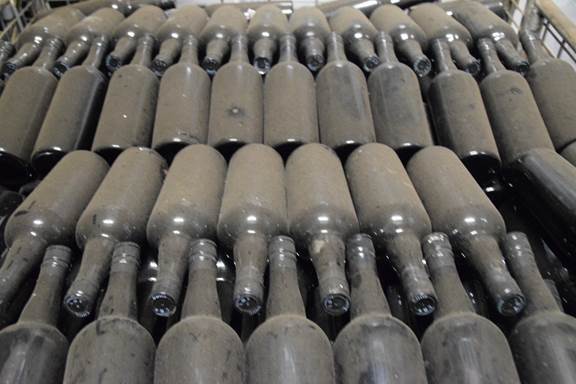
Finally, there are over 250,000 bottles of Port wines stored at the facility.

The Remaining Stocks of the 1952 Dalva Golden White Port
We adjourned to barrel room, where we were also joined by Elsa Couto, Export Director for C. da Silva. We had a lineup that included 10, 20 and 40 year old white Ports, and of course, some of their legendary Golden White Colheita Ports.
 |
 |
|---|
Dalva 10 Years Old Dry White Port. Bottled 2015. Clear, light amber-pink in color. Some tropical fruit and some heat on the nose. Some light hints of caramel and honey on the palate. Good complexity and acidity, with some pronounced heat. 89 points. 9/28/2015
Dalva 20 Years Old Dry White Port. Bottled 2015. Amber with pink hues. Honeysuckle on the nose with a touch of spirit. Light, nutty notes with some noticeable alcohol on the finish. 88 points. 9/28/2015
Dalva 40 Years Old Dry White Port. Subdued nose. Not a lot of discernable aromas coming off the nose right now. Some orange peel on the nose and still some heat. Buttery smooth caramel notes on the palate, with some tropical fruit underneath. Medium-full bodied with bright acidity. 91 points. 9/28/2015
1971 Dalva Golden White Colheita Port. Bottled 2015. Light orange in color. Some spirit and woody notes on the nose. Full body with flavors of pralines and orange spice. Some spice on the mid-palate, and a long finish. 92 points. 9/28/2015
1963 Dalva Golden White Colheita Port. Light amber in color. Orange peel and some sea salt on the nose. Great, balanced intensity. Crème Brule and toasted almonds on the palate. Long finish with bright acidity. 93 points. 9/28/2015
Gran Cruz, owner of C. da Silva, has been managing the vines at Quinta do Ventozelo since 2011, but outright purchased the Quinta in October 2015. We were also able to try the 2011 Late Bottled Vintage Port from Quinta de Ventazelo:
2011 Quinta de Ventazelo Late Bottled Vintage Port. Primary fruits on the nose – blackberry and crushed blueberry. Very dark purple in color. Huge primary fruit on the palate – this will be an interesting wine. N/R. 9/28/2015
“19xx” Dalva Golden White Colheita Port. Cask Sample. (The year of this Golden White Colheita has not yet been made public.) Very smooth wine. Elegant, approachable wine with balanced caramel and toffee notes. Long finish with great acidity and balance on the finish. 90 points. 9/28/2015
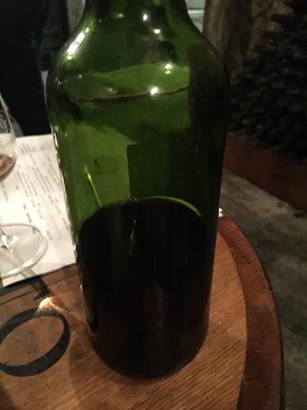
“19xx” Dalva Golden White Colheita Port
It was great to see Gonçalo again, but after a fabulous day tasting Port in Vila Nova de Gaia, it was time to head off to dinner and then for a good night's rest at Hotel Teatro.
FTLOP Port Harvest Tour Day 3
Quinta do Crasto
On Tuesday morning, I woke up, ate a hearty breakfast at Hotel Teatro, and then boarded the trusty minibus with the rest of the guests to head up into the Douro Valley. Our destination this morning was one of the mainstays of our tours over the years - Quinta do Crasto.
Quinta do Crasto dates back to at least 1615, and the Quinta was already officially recognized by 1761. It has a connection to the Constantino's Port House in its ancient history, and was purchased in 1981 by Jorge and Leonor Roquette. Today, their sons (and our good friends) Miguel and Tomas are involved in the family business.
We arrived at the bottom of the hill, where a truck was waiting to take us up to Quinta do Crasto. We piled into the back, and I must say it was a beautiful, scenic, winding drive up to the Quinta.

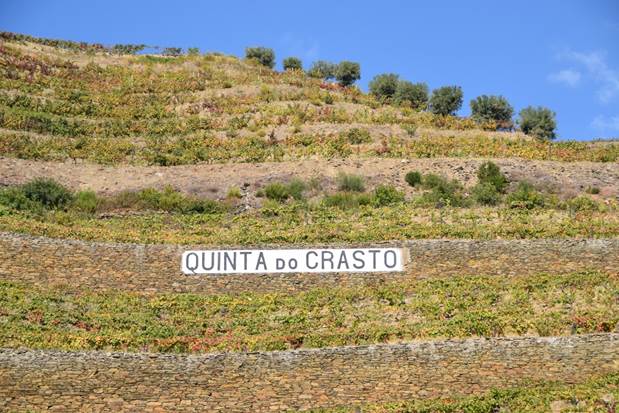
Quinta do Crasto has perhaps one of the most picturesque views of the Douro. The Douro River makes a gentle bend in the distance, lined on both sides by vineyards.

One of the highlights of the trip to Quinta do Crasto was visiting the legendary Maria Teresa Vineyard. The “vinha velhas” or “old vines” vineyard was planted in 1912 as a "field blend" vineyard. In modern "block planting," you might have sections of Touriga Nacional grapes, separate sections of Tinto Cão grapes, etc. that you could harvest and blend together to make your wines. The Maria Teresa vineyard, however, consist of many different varieties all planted together. All the mixed varieties are picked together, crushed together and vinified together making an instant, and amazing, blended wine.

Maria Teresa Vineyard
For many years, Quinta do Crasto has hired botanists to come out to test and type the different varietals in the Maria Teresa Vineyard, and at last check I believe they had identified 36 different grape varietals in the vineyard. Manual Lobo, Winemaker for Quinta do Crasto, provided some interesting data around the varietals that they had discovered:
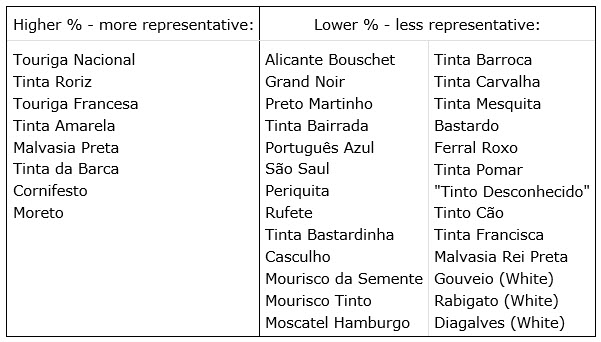
While this is an interesting scientific and viticultural endeavor, there is also a practical reason for knowing specifically what grape varietal each vine is. If any of the vines die or are damaged, as some were when a tractor once rolled down through one of the vineyards, they know the exact botany of the vine so they can replace it with the same grape varietal. Thus, they can maintain the integrity of Maria Teresa’s special “field blend.”
 |
 |
|---|---|
Manuel Lobo
|
Quinta do Crasto’s Patio |
After a tour of the vineyards, we headed back up to the main house to taste some wines and have some lunch. We started our tasting with a lineup of Quinta do Crasto Late Bottled Vintage Ports (LBVs) and Vintage Ports.

2000 Quinta do Crasto Unfiltered Late Bottled Vintage Port. Bottled in 2006. Eucalyptus on the nose, with some dark fruit notes underneath. Intense primary fruit (blueberry and black currant) on the approach. Full bodied with tannins poking through on the mid-palate. Some mocha notes on the finish. 89 points. 9/29/2015
2004 Quinta do Crasto Unfiltered Late Bottled Vintage Port. Bottled in 2008. Dark purple with bricking on the edges. Violet and some herbal notes on the nose. Unctuous mouthfeel. Blackberry and some dark plum on the palate. Grippy tannins on the mid-palate and some fresh acidity with a touch of bitterness on the finish. 88 points. 9/29/2015
2011 Quinta do Crasto Unfiltered Late Bottled Vintage Port. Bottled in 2015. Very dark, opaque purple with bricking on the edges. Boysenberry, primary blueberry and some floral notes on the nose. Raspberry on the palate, with a touch of licorice. Pronounced tannins on the mid-palate, leading to a long finish. This is a great 2011 LBV and could go 20 years. 90 points. 9/29/2015
2000 Quinta do Crasto Vintage Port. Floral and herbal notes on the nose. Pomegranate and hints of tight, dark fruit on the palate. Grippy tannins on the mid-palate. Unctuous mouthfeel and noticeable tannins on the very long finish. 89 points. 9/29/2015
2004 Quinta do Crasto Vintage Port. Impenetrable purple color with slight lightening at the edges. Ripe blueberry and blackberry on the reluctant nose. Raspberry and sour cherry on the palate. Waves of flowers, tannins and a touch of bitterness on the long finish. 88 points. 9/29/2015
2011 Quinta do Crasto Vintage Port. Dark purple with a garnet edge. Primary blueberry and violet notes on the nose. Amazingly smooth approach given that this is a 2011 VP. Crazy structure and all the components that will likely evolve into an interesting VP. The mid-palate just explodes with unctuous fruit and tannins. 92 points. 9/29/2015
Quinta do Crasto has a wonderful patio dining area with a picturesque view of the Douro River, so after the formal tasting, we headed out to the patio where we got to enjoy some sunshine, socializing, and some of Quinta do Crasto’s red and white table wines.
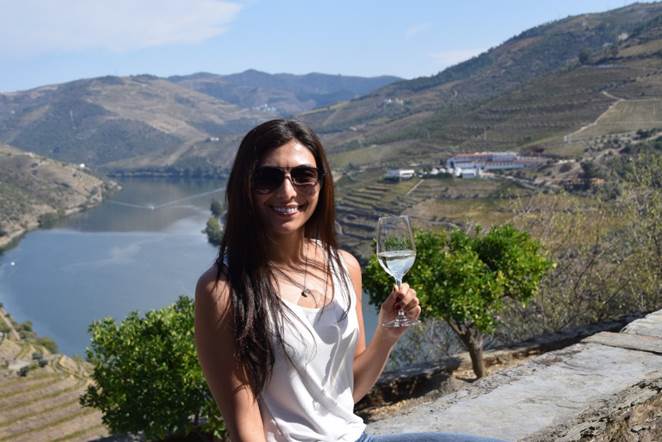
Ayesha Trump enjoying…wait, is that WATER????

2014 Quinta do Crasto DOC Douro White Wine. N/R.
2014 Quinta do Crasto Superior DOC Douro White. Great touch of oak on the nose, and the oak gives this wine great aging potential. 92 points. 9/29/2015
2007 Quinta do Crasto Reserva Douro Red Wine. N/R. 9/29/2015
2005 Quinta do Crasto Touriga Nacional Douro Red. Ruby in color. Rose petal and red fruit on the nose. Full bodied with great, integrated tannins. Long finish. 92 points. 9/29/2015
1999 Quinta do Crasto Vintage Port. Medium purple in color. Deep violets and dark fruit on the nose. Intense blueberry and great balance and tannins. Long finish. 94 points. 9/29/2015
2006 Quinta do Crasto Vinha Maria Teresa Douro Red. Beautiful dark fruit on the nose. Intense, compact and well integrated fruit on the palate, displaying blueberry and cassis. Very long, structured finish. 94 points. 9/29/2015

 |
 |
|---|
 |
 |
|---|
We said our goodbyes to Manuel and took the bus back down the hill to the Douro River. When we arrived, we had a surprise waiting for us: a traditional barcos rabelos to take us to our next stop. The rabelo style boat was used for centuries to transport Port wine from the Douro Valley to Porto. There is really something enjoyable about cruising on the Douro River with friends after an afternoon of tasting amazing wines.



After the boat trip, we landed at the dock next to the renowned DOC Restaurant, and walked across the street to our hotel, a relatively new property that is well-situated for easy transportation around the Douro.
After settling in at the hotel, we met back up in the lobby to walk back across the street to DOC for dinner. DOC is run by Chef Rui Paula, and is one of our favorite restaurants in the Douro. It has an excellent wine selection, amazing food and panoramic view of the Douro River. The restaurant sits on a dock above the Douro River, and on warm days the dining experience on the dock is quite something.

Rui Paula is a masterful chef, and his style blends local ingredients, prepared in a fresh and sometimes modern way that honors tradition but allows him to create playful expressive dishes.
 |
 |
|---|
As we settled in around the table and were served our first wine and appetizers, Roy mentioned that we would be having a surprise guest joining us for dinner. Within minutes, our dear friend George Sandeman arrived, along with Sandeman’s Head Winemaker, Luis Sottomayor.
George is one of the most jovial characters in the Port Trade, and he wears many different hats: he is a Board Member and works in Public Relations for Sogrape Vinhos S.A. (who own Sandeman), and is Chancellor of the Confraria do Vinho do Porto (Port Wine Brotherhood). When he plopped down in the chair beside me, I knew I was in for a fun night.
We started off with a number of amazing courses, paired with Casa Ferreirinha wines (also owned by Sogrape Vinhos S.A.):
2014 Casa Ferreirinha Douro Reserva Planalto. N/R.
2014 Casa Ferreirinha Vinho Grande Vinho Branco. N/R.
2012 Casa Ferreirinha Antonia Adelaide Ferreira Vinho Branco. N/R.
2011 Casa Ferreirinha Antonia Adelaide Ferreira Vinho Tinto. N/R.
2011 Casa Ferreirinha Quinta da Leda Douro Red. N/R.
We were very fortunate to have Luis Sottomayor join us. He is the award-winning Head Winemaker for Sandeman, and he provided us with deep insight about the wines we were tasting. Luis also heads the Enology team for Casa Ferreirinha and all of the Sogrape Port wine brands. He won the 2010 Winemaker of the Year Award in the Fortified Wines category from Revista de Vinhos, one of Portugal’s most prestigious wine publications. He was nominated for the same award in 2012. In 2012, he was also nominated for the Winemaker of the Year at the International Wine Challenge. He is passionate about making wine, and it was really a pleasure to hear him talk about his wines.
As we started to get into the desserts, George brought out several of his Sandeman Ports, including a 2013 Vintage Port, and two classic Sandeman Tawny Ports.
 |
 |
|---|---|
2013 Sandeman Quinta do Seixo
|
Sandeman 20 Year Old
|
 |
 |
|---|---|
George Prefers the Sandeman
|
Two very, very serious Port drinkers. |
We had a marvelous evening with George and Luis, and I honestly walked out of the restaurant with my cheeks hurting from laughing so much. We all said our farewells, walked back across the street to our hotel, and closed the chapter on another day of the 2015 FTLOP Port Harvest Tour.
In the next FTLOP newsletter, there will be a second part to this feature article on the 2015 FTLOP Port Harvest Tour!

Leave A Comment
You must be logged in to post a comment.